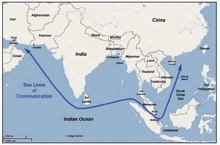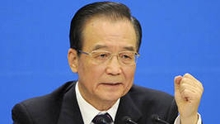With each year that passes, China’s economy comes more and more to resemble that of an “Island state,” i.e., an economic system with a near critical dependence on importing raw materials. Japan and South Korea can be cited as examples of such a system, and Great Britain when it was still a powerful industrial and exporting country serves as an excellent historical example.
China at present is much less dependent on raw material imports than Japan. China has substantial resources of its own. However, Chinese demand for raw materials grows every year, and it grows dramatically. As the standard of living of its people improves, so does their demand for food, especially meat and fish, and the demand for petroleum products increases as its automotive industry develops. For example, China once provided energy resources both for itself and several of its neighbors. After production and foreign trade intensified beginning in 1993, China transitioned from being an energy supplier to an oil importer, and, it has held second place after the United States in that category since 2003.
China is one of the largest countries in the world, and its size has a definite psychological impact. However, high mountainous regions like Tibet and desert areas like the Gobi or the Tarim lowlands make up about half of China and are unsuited to development. China’s most successful economic zone is in the eastern part of the country and in its northeastern and southeastern coastal provinces, with their mild climate, high crop yields, low manufacturing costs and municipal services. Most Chinese live in these provinces, which are inhabited primarily by the Han national majority.
Foreign trade. China currently is the industrial leader of the global economy and the world’s largest commodity exporter. According to People’s Daily Online, China’s exports in August totaled $173.31 billion, a 24.5% increase over August 2011. From January through August 2012, China’s total foreign trade amounted to $2352.53 billion, up by a quarter in comparison with the same period during 2010.
I should also say that, according to South China Service Group, 185 of the top 200 Chinese export corporations are located in the eastern provinces, i.e., close to China’s largest port centers.
China’s major trading partners are the United States, the European Union and Japan. They account for more than half of China’s total exports. As we know, these countries’ economies are the main reason for the global crisis. Their debt, both domestic and foreign, is huge and growing. One of the most effective ways of lowering debt is to reduce government spending (especially on defense) and lower salaries and social spending for employees.
For example, if the United States can tighten the belt on its people, the administration will not cut arms programs. Obviously, that will only make US foreign policy more aggressive and force its government to seek revenue sources outside the country by force of arms. Recent events in the Islamic world testify to that.
Since people’s living standards in the United States, the European Union and Japan are likely to decline during this decade, China expects its export revenues to drop sharply.
China’s Ministry of Commerce press secretary, Shen Danyang, said Chinese exports could stop growing during the second half of 2012: “Right now, the sharp drop of exports to EU countries is the biggest important factor weighing on China’s export growth. With the European debt crisis spreading and the global economy recovering at a slower than expected pace, we expect China’s trade situation in the second half will become more severe and we are facing more pressure to meet the annual target for trade growth.”
Former Commerce Minister Wei Jianguo believes the worst is yet to come: “The volume of Christmas orders is lower than usual, and, after all, manufacturers get most of their income from orders for Christmas gifts.” He believes the Chinese government urgently needs to lower export duties and increase government assistance to companies seeking to expand into new markets, particularly Russia, Brazil and countries in Southeast Asia. These countries currently account for only 20% of total exports.
The Chinese government is prepared to help its trading partners remain financially stable. In early November, Li Daokui, a member of the monetary policy committee of China’s central bank, said Beijing is willing to give the EU $100 billion. However, the Chinese government expects something in return.
“We want to help, but we are not a charitable organization,” a source told Reuters.

Finally, at the talks in Brussels during the EU-China summit in September, Premier Wen Jiabao demanded that the embargo on arms sales to his country introduced in 1989 following the events in Tiananmen Square be lifted and tariffs on some Chinese goods be abolished.
Meanwhile, it should be noted that Chinese assistance to the EU, even if no strings are attached, can only delay the West’s economic crisis. The solution to Europe’s problems needs to be systemic in nature; patching its financial holes with Chinese money would have no real impact.
So, unless the financial positions of the EU, the United States and Japan improve soon, China will, first of all, have to find new foreign markets and expand trade with alternative partners (Latin America, Russia, Africa, etc.) and, second, increase the capacity of its domestic market.
China trades with its major (and not just major) trading partners primarily by sea. The route for Chinese goods flowing to Europe, for example, begins on its east coast and passes through the Strait of Malacca, the Indian Ocean, the Red Sea and the Suez Canal to reach the Mediterranean Sea. Ships travel on from there to European ports.
China’s main oil suppliers are countries in the Middle East and Africa: Saudi Arabia, Iran, Sudan and others, including Angola. According to Reuters, by 2015 Chinese oil imports will grow by 10% — to 65%. The Chinese government works hard to diversify its energy supplies. The main route for Middle Eastern oil shipments to China is the “String of Pearls,” which passes through the Persian Gulf, the Indian Ocean, the Strait of Malacca and the South China Sea. Naval control of the route is very important to China, but it is controlled by the US Navy’s carrier task forces. That means China’s foreign trade problems are closely linked to its military-strategic problems.
Konstantin Alexandrovich Penzev is an author and historian and a columnist for New Eastern Outlook.
